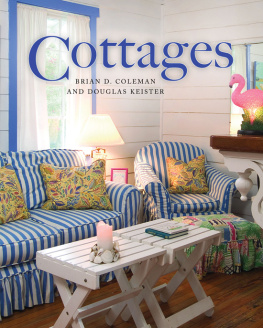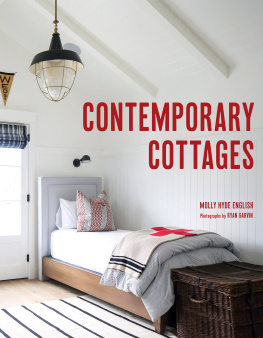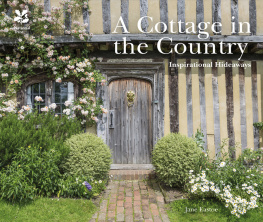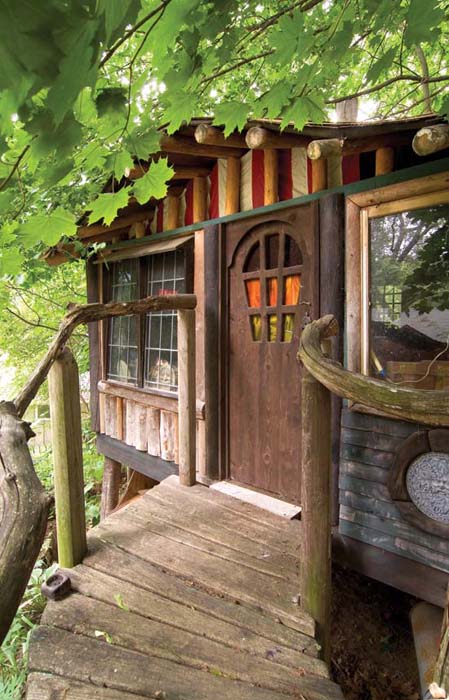The authors wish to thank all of the homeowners and designers who graciously opened their homes to us, both of our Sandys (Mclean and Susanto), and as always, our fantastic agent, Julie Castiglia, and our wonderful editorial team at Gibbs Smith, Publisher.
Introduction
Just what is a cottage? Characterized as a small, romantic dwelling, a cottage can range from a simply restored fishing shack overlooking cattails on a riverbank to a colorful casita surrounded by cacti in a sunny southern Californian suburb. Casual, comfortable, and inviting, cottage interiors should not be too serious. They are a place to relax and unwind from the stress and pressures of modern life, an escape to a slower time and pace where simple pleasures can be appreciated.
Cottages gives ideas and inspiration from across North America for cottage-lovers of all persuasions. We take you to the picturesque Catskill Mountains in upstate New York, where rustic, nineteenth- century cottages perch on mountain slopes in charming communities with names like "Twilight." With interior staircases of golden birch logs, their bark still intact, and diamond-paned windows overlooking the treetops, these simple, mountain retreats are hard to resist. Furnished with warm, colorful Turkish rugs and pillows and simple tag-sale sofas and chairs, these snug cocoons are the perfect places to spend a long weekend just sipping hot chocolate and savoring the leafy tranquility of the mountaintop.
While many are rustic, cottages can certainly be urban as welltake, for example, a narrow aluminum and corrugated steel building that for all outward appearances is a small warehouse in an industrial area of Victoria, British Columbia. Once inside, you realize this is a futuristic creationa true cottage of the twenty-first century, complete with furniture that slides away into the floor with the flick of a switch and an underground swimming pool.
The seashore is traditionally a favorite spot for cottages, and we visit a beautiful seaside community: sunny Tybee Island off the coast of southern Georgia. Full of small homes and diminutive guesthouses, many just plain wooden shacks built in the early twentieth century for summer and weekend holidays, Tybee Island today is a cottage lover's delight, thanks in a large part to designer and preservationist Jane Coslick. Over the past decade, Jane has restored dozens of these simple buildings, infusing them with new life and giving them a fresh, laid-back charm. Painted with bright, cheerful colors such as rain-slicker yellow and seafoam green and furnished in a casual country chic, these cottages invite you to take a deep breath, kick off your shoes, and just relax.
The appeal of cottages began for many in the 1920s with the resurgence of interest in historic architecture. Spanish Revival cottages in particular were appealing to homeowners, especially in California, where the climate and geography mirrors that of Spain. We visit a lovingly restored example in San Diego, whose red tile roof, rough plaster walls, and original wrought iron light fixtures evokes a simple and devout Franciscan monastery. Designed and built as a model home in 1926 by Richard S. Requa, a popular architect of the period, this cottage championed the simplicity of the sun-washed white stucco farmhouses of Spain.
Tom Mix was a popular star of the silent screen who spared no expense when he built a Spanish Revival cottage for his mistress in 1926 (even though she later left him to marry Hopalong Cassidy). Beautifully restored in the 1990s, the cottage features hand-stenciled ceilings, handsome Malibu tile fireplaces, and rooms painted in a colorful Mexican palette of bright blues, reds, and oranges. Furnished with period Mission, Spanish Revival, and Craftsman pieces, the cottage is at once colorful, comfortable, and inviting.
We hope that Cottages will help you to create a cottage of your own. Remember, a cottage can be anywhereperched among trees on a mountaintop, nestled among the sand dunes on a sunny, windswept island, or just tucked away on a pleasant suburban lane. After all, it's really only a state of minda special spot to unwind and reenergize so that we can face life's challenges with renewed vim and vigor.
An Artist's Cottage in the Catskills
The Catskill Mountains in upstate New York have long been a favorite getaway for metropolitan New Yorkers, especially during summer when the heat and humidity of Manhattan becomes unbearable. Many resort communities were built in the area during the nineteenth century, including Twilight Park in 1887. Formerly sheep pastures, the development was perched on 160 steep acres of Round Top Mountain and offered unsurpassed views of the forested Kaaterskill Clove (Dutch for "canyon") below. Its founder, Charles F. Wingate, gleaned the community's name from New York City's Twilight Club, an organization of New York businessmen who met to discuss topics of general male interest (such as "How Should Our Girls Be Trained?"a debate on the merits of women wearing corsets). Wingate was a tireless promoter, and it wasn't long before other members of the Twilight Club began discovering the Catskills' charms. They began purchasing lots and erecting rustic summer cabins. Over the next several decades, more than 100 cottages were built. While some were substantial, most remained simple and rural, with straightforward interiors of unstained wooden wainscoting and log stair railings, often golden birch with the bark still intact.
When Joe Keiffer came across his Twilight cottage in 1989, it hadn't changed significantly since it was first built in 1897. Perched on a mountain slope, it seemed suspended in the surrounding trees, and balconies on three sides gave breathtaking views over the steep Clove below. Built for friends and followers of a local minister whose own house was just down the hill, the house was meant as a mountain retreat with split-log siding and interior walls of fir wainscoting. Nearly a century later, the old knob and tube wiring was still in use, the upstairs walls and woodwork had been painted an indigestible peppermint green, and the kitchen had been "modernized" in 1952 and (fortunately) never updated. But Joe, a professional artist, was drawn to the cottage's rustic charms and sweeping views that reminded him of a Thomas Cole painting. He set to work slowly restoring the home but keeping intact as much original detailing as possible. The parlor woodwork that had been painted white was methodically stripped and cleaned to restore its mellow glow. Joe also returned the simple brick fireplace to its original red brick. He revarnished the oak floors and cleaned and repaired the original sash windows to working order.
Joe used his artist's eye to guide him as he refurbished the rooms. Exotic influences were popular in the late nineteenth century (as seen in Olana, Frederick Church's Byzantine estate overlooking the Hudson River), so Joe added some exoticism of his own: a large, Oriental gong as a fireplace screen, colorful Chinese lanterns for lighting, and rows of peacock feather fans strung along the walls. Worn, comfortable wicker chairs, a Mennonite rocker from Pennsylvania, and enameled tin cups stacked on a shelf all helped create a casual, inviting ambience, one in harmony with the house and its humble nineteenth century origins.














